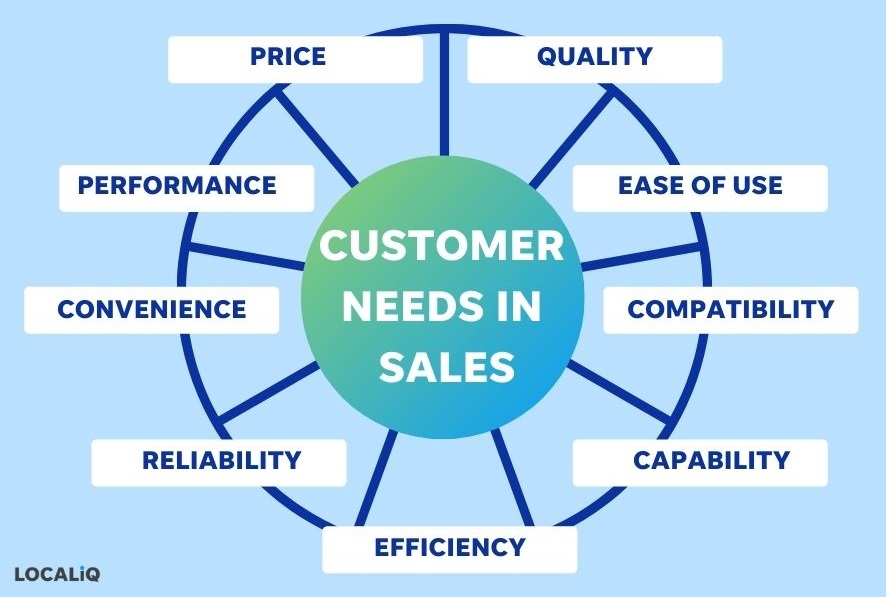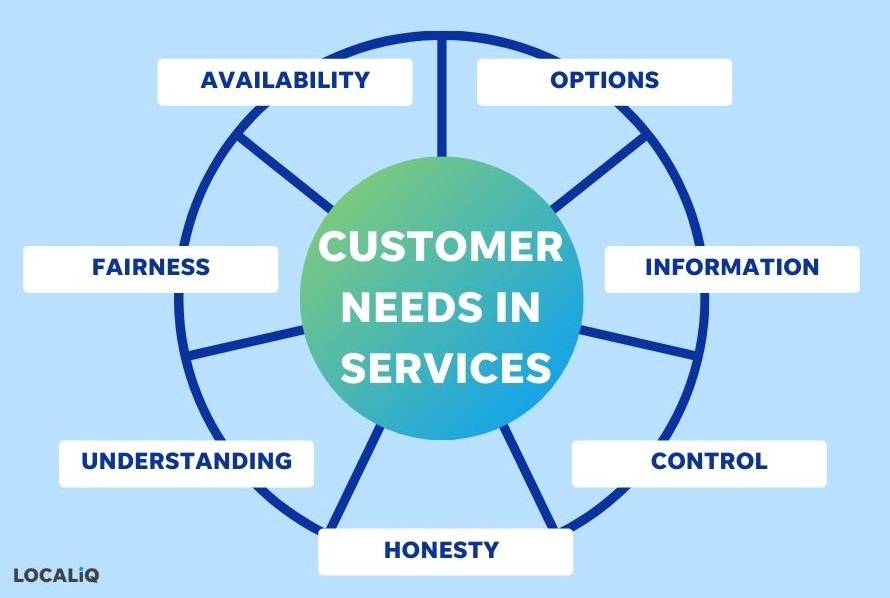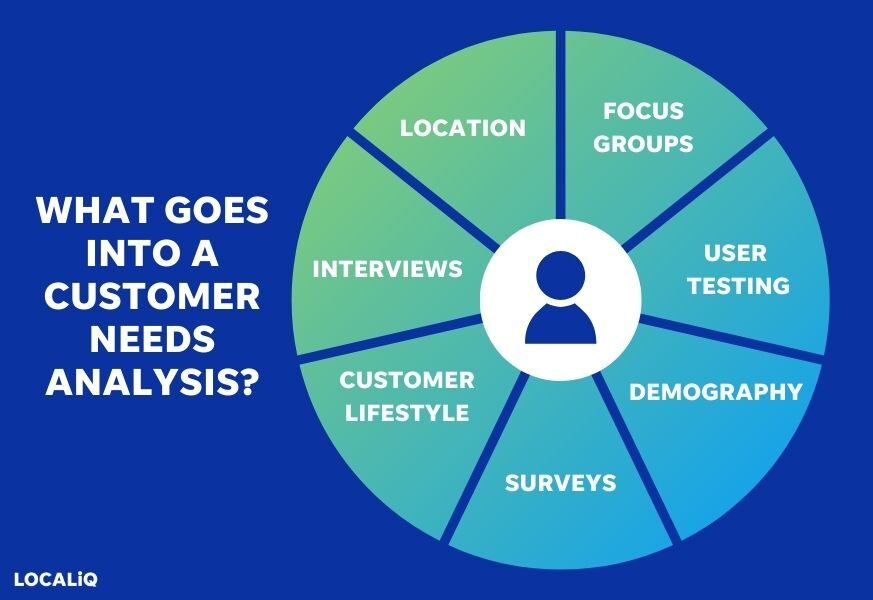More often than not, when a business wants to succeed, they turn to look at their competition. They look at what other companies are doing or the newest product releases. They may even check out current fads and crazes.
But do you know what they often don’t look at?
Their own customers.
That’s right! The key to success as a growing business has been right under your nose this whole time. Customers are the ones that have the power to make or break a business.
But how do we know what a customer needs? Understanding the human mind can’t be that hard…Can it?

If only it were that easy…
When we talk about customer needs here, we aren’t just talking about what products they need. We’re talking about everything from store and office location to product improvements to perfectly placed advertisements.
This post will tell you everything you need to know about customer needs, like:
- What are common customer needs?
- How to identify and meet your customers’ needs.
- How your business can get ahead of its customer needs.
Ignoring customer needs truly is a recipe for disaster. But, there is no need to fear! We are here to help.
What are customer needs?
Customer needs motivate customers to invest in a particular service or buy a specific product. Customer needs influence a customer’s decision-making during the purchasing process—from initial interest to completion. In other words, knowing your customer needs now will help your business to get more customers in the long run.
Customer needs aren’t the same thing as what a customer wants. They need food to live, but they could want a pizza, a fruit salad, or any other dish that might be available.
There are 16 common types of customer needs that can be split into two categories. Needs when buying a product and needs when purchasing a service.
Customer needs in sales
Whether you’re an e-commerce business focused on mobile marketing, a family-owned shop starting out in local marketing, or any business in between, here are the customer needs that apply when they’re buying your product:
- Quality: Customers need a product that lasts for a long time.
- Price: Customers have a specific budget and need a product that falls within that range.
- Ease of use: Customers need a product that is designed to be easy to understand or at least comes with clear instructions.
- Capability: Customers need a product that functions in the way that they need.
- Compatibility: The product needs to work in conjunction with the customer’s other products.
- Performance: Customers need the product to work correctly so the customer can complete their tasks.
- Convenience: The product needs to be an uncomplicated solution to the need your customer is trying to meet.
- Reliability: Customers need the product to function effectively every single time it is used.
- Efficiency: Time is money, so the customers need the product to streamline an existing process.

Customer needs in services
If you’re a growing service franchise, a local home services business, or any service-based business in between, here are some customer needs that apply when selling a service:
- Availability: Customers need multiple accessible channels in order to get in contact with you and your team whenever they may need.
- Options: Customers need choices when it comes to services offered, payment plans offered, prices offered and even the type of payment methods offered.
- Information: Customers need to always be kept in the loop and to be given enough information so that they get the most out of your service.
- Control: Customers need to have some sense of control from start to finish.
- Honesty: Be sure to address customer pain points with transparency.
- Fairness: Customers need to be treated fairly and offered services fairly in every regard from the price of the service to the length of the contract offered.
- Understanding: When dealing with other people customers need empathy, particularly when it comes to customer service.
Depending on your unique business goals, you may need to mix and match these different types of customer needs. You can use these handy lists to identify your business’s specific customers’ needs.

Factors that impact customer needs
When your customers are going through their buyer’s journey there are many factors they may consider before deciding, like:
- Culture: A customer’s culture can significantly impact buying decisions. Some people actively seek out food from other cultures, while others avoid it. Culture can be ethnic, but it can also be based on hobbies, work, or even neighborhood.
- Familiarity: Familiarity covers how well a customer knows a particular product or company. If a customer already trusts a company, they’re more likely to buy a new product from that business. For example, meme marketing has emerged as a potent way for businesses to familiarize their audiences with their brand.
- Information: Does the product description include adequate information about it? Sufficient information could be technical specifications, nutrition information, or anything else relevant to the product.
- Payment Options: How can people pay for your products or services? Are there any unique options, like payment installments, QR codes, or online processors like PayPal?
- Personalization: Can the product be customized? Personalization can range from getting engravings on the outside to picking the interior components or adjusting them for their use.
- Price: What’s the actual cost of the item, and does it feel like a good deal? Don’t forget that even the appearance of a sale can entice some people to buy.
- Reviews: Are other people talking about this product, and if so, what are they saying? Getting Yelp reviews, or asking for referrals to build out your Google Business Profile, can help your potential customers understand if your brand is reliable and trustworthy.
- Speed: How fast can your customers get their product? For example, they may need to drive to a store versus ordering online or have to wait on standard shipping. If they need it quickly, they may be willing to pay a higher price.
- Urgency: Is there a time limit on when they can buy the product? Some luxury goods can sell out before they’re even released to the market. FOMO is a natural phenomenon, and the sense that something may not be available later can push people to buy.

Most customers fundamentally want to feel understood by companies.
Being understood means having their needs addressed and getting quick responses when they have questions. If you take too long to respond to inquiries, customers might think you don’t care or that your products may not be as good as advertised.
You could then use this information to create an ideal user persona that will boost your sales funnel even more by helping you to identify your target audience.
One thing that’s easy to overlook is that some customers don’t care about all of the areas above. The same pizza that’s too large for one customer can look like perfect leftovers to another. Appealing to both sides of the issue can often net you more customers than focusing on one area.
This is the concept of the Contractor’s Triangle in that most people will prioritize two parts and willingly sacrifice the third. They may want something to be excellent and fast but not care about being cheap.
Alternatively, they might want something cheap and good, but they’re willing to wait to get it.
Many customers want all three components if they can get them, but you shouldn’t sacrifice your business in return since we know they’re willing to compromise.
With the Contractor’s Triangle concept, one of these three customer needs would need to be sacrificed.
How to meet your customers’ needs
The good news is you can meet your business’s customer needs in five simple steps. Let’s take a closer look at each way you can meet your customer’s needs:
1. Have exceptional customer service
More than anything, customers like to feel heard and seen. Having easy and efficient customer service channels inspires customer loyalty. It is important that a customer’s question gets answered, or the problem gets resolved as soon as possible.
Most customer-related issues are time-sensitive. If your business takes too long to respond, you risk losing that customer. Be sure that you’re responding to negative reviews, and keep checking your feedback outlets regularly to maintain brand consistency.
If this feels like a challenge, you can streamline your customer communications by leveraging a marketing partner to optimize your local listings for you.
Or, you could optimize your website to deal with any customer issues using tools like live chat. The benefits of live chat are endless, but the main reason you might want to consider this strategy is that any problem can be effortlessly solved in record time. Whether the problem is simple or complex, live chat is there to solve it for your customers 24/7.
Related: Is your website ready to help meet your customer needs? Find out with our free, instant website grader.

An example of using live chat on a website to answer customer feedback and meet customer needs.
2. Get to know who your customer is
Not only do you want to identify your target audience, but you should also be able to anticipate what they might need or want. A customer needs analysis is the perfect exercise for this:
Customer needs analysis
A customer needs analysis is an in-depth examination of what real customers want and need.
There are many ways to conduct this analysis, including:
- Demographics: It might sound silly at first, but take a moment to visualize your ideal customer. What might that person’s age, ethnicity, or income be?
- Focus Groups: Focus groups allow for personal interaction with a group of customers that have diverse backgrounds and experiences. These groups are valuable for a customer needs analysis because finding shared preferences or complaints can help companies focus
- Geographic Data: Where do your customers live? The separate state, city, and even neighborhood can influence their behaviors and how you should approach them.
- Interviews: Interviews are one-on-one discussions that let companies get particularly in-depth and cover things that shorter analysis tactics won’t cover. Have a meeting agenda template to scale your interviews.
- Psychographics: Psychographics focus on the mental aspects of customers, such as their lifestyles and principles.
- Surveys: Surveys are a quick way to gather information about specific topics. You can survey existing customers or reach out to the general public.
- User Testing: Actual user testing focuses on getting impact from real users. This testing is particularly effective in product development when helpful feedback can help shape the final product and achieve product-market fit.
A/B testing your landing page is an example of a helpful technique for customer needs analysis. These can guide users into specific workflows or screens and help you determine what’s most effective.
When it comes to your customer needs analysis, constant testing and improvement over time works best. You business needs to collect all the right marketing data and analyze it accordingly. Connecting your tools and services will help you gather all the data in one place, leverage reporting, and create dashboards.
A good customer needs analysis also involves looking beyond company-generated surveys and information gathering techniques. These can introduce unconscious biases into the reports. Researching discussions online can help you understand what consumers think about your products or services.
That way you can find out your business’s customer needs in real-time.
Similarly, local keyword research can help your small business determine what matters most. Details like the volume of searches and common questions people ask can help you determine an oversight in your advertising strategies.
Remember to focus on pain points, which are a significant factor in consumer behavior. Most people want to solve problems they have in their lives, so convincing them that they have a problem and offering a solution is highly effective.
Related: Wondering what terms best meet your customers’ needs? Try WordStream’s free keyword research tool.

3. Be ahead of your customers’ needs
Identifying your customer needs as they arise is one thing, but predicting your customers’ needs before they even know what they need themselves is another.
You can uncover consumer trends manually by keeping track of all the customer data you collect and analyze over the years. For example, knowing the bulk of your customers’ historical buying patterns is key.
Artificial intelligence can also be used to predict the future. The best thing about AI in marketing is that it does the hard work for you. Artificial intelligence uses predictive analytics to determine trends. This means that you can always stay one step ahead of your customer and your competitors.
4. Create business workflows
Use business workflows to meet the needs of customers. In other words, your business should be responsive and flexible enough to adapt to what customers want.
Start by integrating data collection into your regular practices.
Doing this includes:
- Monitoring customer support calls and tickets
- Reviews
- Feedback loops
- User testing
- Discussions on social media
All of these are excellent references that can produce timely, relevant data.
From there, expand into focus groups and pre-development work, even if your product is already released. This step can help you focus on what customers want and how you can change and improve your existing products.
Feedback loops at every stage allow companies to better understand their customers’ needs and make adjustments and improvements based on this.
The main point here is to keep developers fully in the loop to understand what problems people are having so that your offers are fully optimized to meet customer needs.
5. Have consistent messaging throughout all layers of your business
Customers need to hear and see the same thing throughout their customer lifestyle. In fact, people need to see or hear something at least seven times before it sticks. This means your entire company needs to be on board when it comes to any brand awareness strategies. Consistency is key, so here are a few ways to align all portions of your business with your customer needs marketing plan:
Align your sales, marketing, and support strategies
Do you need to operate like an enterprise-scale corporation?
As a growing business, the answer is probably “no,” which means it’s okay to integrate your sales and marketing areas instead of wholly dividing the responsibilities. Combining these areas with an informative knowledge base will help your departments stick to the status quo.
Some CRM systems actively support businesses with integrated departments. These systems are helpful because sharing leads and analytics data can help keep everyone in the loop.
Likewise, KPIs or analytics information can provide real-time information on what customers are doing and thinking. Google Analytics is the primary tool for this, offering data like where visitors are coming from, which pages they’re visiting, and even where they’re located geographically.
Outside of analytics, behavior analytics software can provide other types of information that your company may be looking for.
At this point, it’s important to remember the actual value of data. It’s not hard to collect lots of information, but it can be hard to get valuable answers and results.
The ability to process data is arguably as important as the data itself, so make sure to decide what you need to figure out and how you’ll apply it.
Setting out objectives and getting key results is helpful here. KPIs, OKRs, and mission statements are all valuable tools for this process.
An example of a mission statement that focuses on customer needs.
Satisfy your customer needs like a pro
Now that you know what customer needs are, what affects and impacts these needs, and how to meet and identify them, you can quickly put this information into play in your business.
Remember, customer focus is key. Customer needs determine whether or not that customer chooses to invest in your product or service. Long-term business success comes more easily to those who know their customers’ needs inside and out.
It is also important to remember that customer needs constantly change, so companies’ products and services need to change with them.
Here’s a recap of the top types of customer needs you need to be ready to address:
- Quality
- Price
- Ease of Use
- Capability
- Compatability
- Performance
- Convenience
- Reliability
- Efficiency
- Availability
- Options
- Information
- Control
- Honesty
- Fairness
- Understanding








